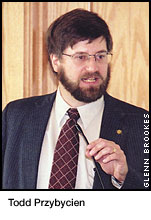
|
 |


Enthusiastic Jane
Jane Ditmore earned the Andy Award for enthusiasm at the eighth annual Andy Awards Ceremony last month in McConomy Auditorium. Ditmore, a senior sales associate in Entropy, is holding a sign made by her colleagues in Business Services. Other Andy Award winners were Anita Barkin, Richard Pethia and the Heinz School Morale and Motivation Committee. More...
|

|
NSF Awards $9 Million to Support Understanding of Proteins in Cells
The National Science Foundation has made a $9 million, five-year grant to a collaboration of researchers from Carnegie Mellon, the University of Pittsburgh, the Massachusetts Institute of Technology, Boston University and the National Canadian Research Council to advance a new field called Computational Biolinguistics.
Computational Biolinguistics, which combines the use of computational tools, including statistical language modeling, machine learning methods and high-level language processing, will allow scientists to better understand how proteins work inside cells.
As in languages, where there are sequences of letters that fall into patterns that make them understandable, there are sequences of amino acids in proteins that can be read to understand their structure, dynamics and function. Sequences of amino acids and their constituents can be thought of as syllables or words that have particular properties. More...
|
New Biomedical Engineering Department Established in CIT
Effort Aims to Meet Demands of Biotech Industry

Carnegie Mellon's College of Engineering has created a Department of Biomedical Engineering to meet the growing needs of an emerging new biotechnology marketplace that pumped more than $4 billion into the regional economy in 2000.
Tapping into a long-established culture of interdisciplinary education and research, the new department offers a double-major curriculum in which each student must complete the requirements of a traditional engineering program plus a palette of nine biomedical engineering courses, ranging from physiology and biochemistry to biomedical engineering design.
"We are the only school offering this dual-major degree in biomedical engineering," said Todd Przybycien, head of the new Biomedical Engineering Department. "We feel students need a broader toolkit to be competitive in today's job market, so our biomedical majors can opt for a double major curriculum that may include mechanical, chemical, electrical, computer, public policy, materials science, and civil and environmental engineering." More...
|
|



